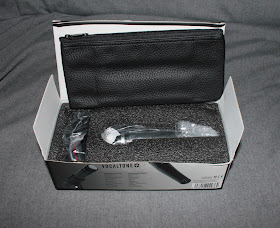Literally last week, a local friend gave me a heads-up on a ridiculous sale that a big electronics retailer nearby was having, on some knockoff Shure microphone clones (of the SM57 and SM58, specifically) - normal price 39,90e; discounted price 10e(!!!). I grabbed three, right off the bat, with the intent of borrowing a legit SM57 and doing some measurements. But then i figured, why not make an article out of it?
But i've got big(?) plans for these, more or less. There's method to this madness, though...
Nicely enough packed - you get a pleather pouch (unbranded), as well as a reasonable clip, that seems to have a decent grip of the mic.
If it weren't for the logo and model number, you'd be hard pressed to notice it's not a real 57, from a distance. Even the weight is right up there with the original. You really need to take a way closer look before you see differences.
Ok, so there's some minor differences in the grill on the top, and there's more of the rubber damping sleeve poking out of the metal body, but other than that, the original and the knockoff are virtually identical. I couldn't really be bothered to "disect" the capsule side of things, but i just had to take a peek inside the body.
The top and bottom parts were (also) glued together, not just threaded together. At least on the one i opened up, the black ground wire turned out to be really short - at least the part still left poking out of the potting compound - and i managed to break it off from the solder lug connected to the center pole piece(?). Nothing an added piece of thin and flexible enough wire couldn't fix.
Spoiler - this thing actually IS transformer-coupled. I had read of fake 57's with just a small transformer core thrown into the potting compound, with no actual bobbin or windings on it. This one is real and functional, though. On an initial measurement between the XLR pins 2 and 3 (ie. the secondary winding of the transformer), i got a reading of about 22 ohms - quite low, almost surprisingly low. Then again, as it turns out, the original measures about 17.8 ohms, so i guess that's not actually all that unreasonable.
After disconnecting one of the wires going to the capsule, i took some further readings. The "voice coil" turned out to be about 18.9 ohms, while the transformer primary measures about 1.8 ohms. As opposed to an original SM57, which measures at 17.8 ohms and 1.6 ohms respectively - "in the ballpark", i think we can agree. Interestingly enough though, no grounding lug / wire in the 57. Safe to assume the mic body provides enough shielding overall, as far as the Shure engineers were concerned.
Well, with the physical / visual / electrical(?) inspection complete, i'd say it's time to get to the "real stuff". More specifically, running some frequency sweeps and then "contrast & compare" the original and the "clones". As a reference, i'm using an EMX7150 calibrated measurement mic, as well as one of my Tannoy Reveal 6D monitors as a signal source; the combined response of both can be subtracted from subsequent measurements, in Room EQ Wizard.
Drumroll, please...
The green trace is the SM57 response, while the other three are the D7's.
Well... Not sure if this should or shouldn't be surprising, but i would at least call it (borderline) remarkable. True, these knockoffs don't have the Shure internal "pneumatic shockmount", so one might expect a bit more handling noise, but at least response-wise, it's laudable either way. Virtually like an SM57, but with up to 4dB more low-end. Where the original starts subtly tapering off below 500Hz, the D7's actually have a slight hump in the 100-200Hz area. The mics were placed in the same clip, so no distance changes, and proximity effect should be a non-issue (measurement distance being just over 1m or so / 3.5ft). Also, the SM57 drops like a stone from about 9kHz, while the cheapos extend up to 11-12kHz before the high-frequency roll-off.
Also noteworthy is the consistency between the three. "Even" for the retail price (which contains 24% VAT, plus the shop needs to make some profit off that too, and freight costs and so on), you might expect far wilder variations, but nope. The biggest differences seem to be within 1.5dB around 900Hz, if we disregard the "outliar" above-10kHz-area.
Before the sale ended, i put in an order for two more, as well as two of the SM58-knockoff versions, because why not? If not for "primary usage", then at least as backups, or talkback mics, or whatever. Especially for 10 bucks a piece...






Some older 57s do have that black wire, one of my three has it. Mid 90s I think.
ReplyDelete